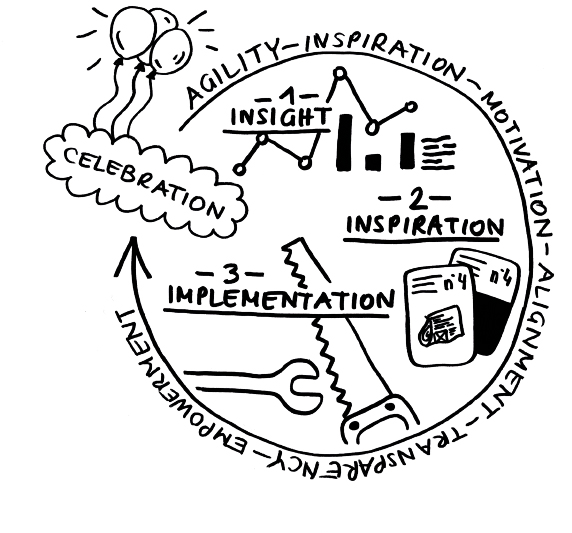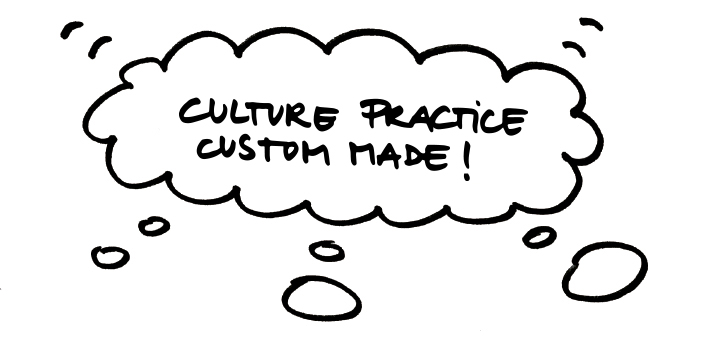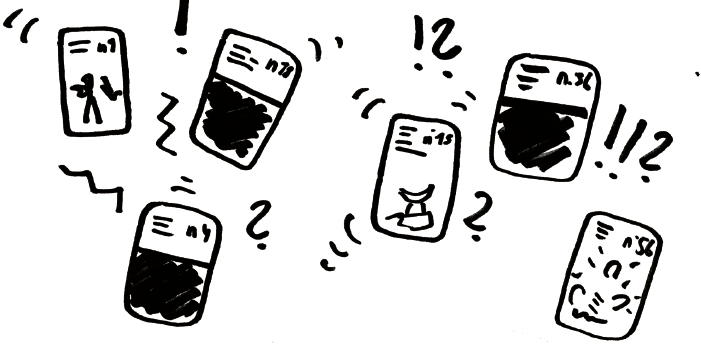3 STAGES TOWARDS CUSTOMIZED CULTURAL PRACTICE
In order to promote your innovation culture, we recommend that the St.Gallen Innovation Culture Navigator is used within a systematic three-stage process.

Precise analysis of your company's status quo due to our systematic assessment tool
Good management needs good data. Even an innovation culture cannot be designed efficiently on the basis of mere instinct. A precise assessment of your innovation culture will identify both the cultural strengths and cultural possibilities, which your company can encounter if suitable cultural practices are selected.
You can start developing your innovation culture by determining the most efficient drivers: Is your biggest challenge that your employees do not produce enough innovative ideas? Does your company lack the right channels to process and test ideas quickly and efficiently? Or do your employees perhaps have very little incentive to implement their innovative ideas within your company and therefore implement them externally?
Systematically measuring your innovation culture and knowing your status quo enable you to focus. You can direct your energy and time into the identified possibilities and thus achieve maximum impact. In addition, your employees are already involved and aware of the innovation culture topic. Giving employees an active role as co-shapers of the company's future is, at the same time, a practical step towards a successful innovation culture.
We assess the six dimensions of your innovation culture by using a standardized measurement tool. You should, however, involve employees from different departments and hierarchical levels. This is the only way to guarantee a truly valid and representative measurement of your innovation culture.
In order to make employee data directly interpretable and action-relevant, your data can be compared to a benchmark. Without such a context, it is difficult to interpret a "four" in the area of agility.
First, you can have internal benchmarking in which different business areas are compared with each other. Second, we enable comparisons amongst companies, which form part of our growing research database. We ultimately recommend using internal time-based benchmarking, whereby a new measurement is performed cyclically (about every twelve or twenty four months) so that trends can be tracked within the company.
These three reference points – especially when combined – enable us to interpret the assessment results and to select the goals for inspiration, which promise the greatest impact.

Selection of 66 culture practices used by innovation champions and adapted to your own company context
Learn from the best and be inspired by the innovation champions' 66 cultural practices.
The advantage of designing an innovation culture with concrete cultural practices is that tangible and visible developments quickly reach employees. The rich and varied perspectives within the 66 cultural practices help break out of familiar thinking patterns and old discussions to consider completely new options for action. Numerous company examples help enliven the cultural practices and provide reference points that help convince colleagues.
The cultural practices cover a very broad spectrum and let you decide how courageously the culture is to be developed: The Heroic Failure Award, which Grey symbolically bestows to improve the way in which failure is handled in a company, is not likely to be controversial – even in conservative companies. The payment service, Stripe, implemented the cultural practice known as Zero Barriers to Users whereby product developers are assigned to customer support for one day a week to bring more empathy and customer centricity into product development. This is a practice with great impact and for which many CTOs need a lot of persuasion.
We recommend a workshop setting, which involves employees from different departments and an experienced (possibly external) facilitator.
You should start with the results of stage one Insight. Present them and reflect upon them: For example, which interpretation results from the comparisons within the benchmarking categories? Based on the analyses, the group should set a focus.
Then you tackle the Innovation Culture Navigator's cultural practices, which fit the selected focus goals and framework conditions. Yet, it is crucially important not to impulsively reject or approve a practice. Work through them in concrete terms: How would this be understood in my company? Who would be affected? What possibilities and challenges arise?
Remember that although the 66 cultural practices are excellent material for inspiration, they must often be adapted to the concrete conditions of the company. The cultural practices which are implemented must match the DNA of the company – do not merely follow any trend. Bosch is a good example. They were inspired by Google's well-known 20% regulation, which allowed employees to work on their innovation projects every Friday. However, in the German corporate culture it was more appropriate to allocate innovation time slots to Tuesday mornings.

Systematic roadmap to a successful innovation culture
You have to continuously deal with your own innovation culture. It is not just a once in a lifetime operation and far from being a static element. That is why you have to anchor innovation culture in concrete routines – routines for how your employees do their work, how they adjust, how they interact with each other, and what they celebrate. We design these routines according to the results in stage two inspiration.
Now it is time to implement and iteratively optimize the cultural practices, which you have selected and adapted.
The iterative character of the process is particularly important here. Although it is becoming more and more widespread in product design, it is still not used frequently enough in organizational and cultural design. The effectiveness of the practice can be optimized step by step via close feedback loops. Simply continue adapting them to the concrete needs and profiles of your employees. At the same time, this design integrates two important success factors of cultural development: Transparency for employees and participation of employees.
Sweet spot thinking: We recommend that you identify and use simple, as well as promising, opportunities to create visible success stories before iteratively rolling out the practice any further. These success stories and the people behind them can play an important role as ambassadors while the cultural practices roll out.
An iterative rolling-out process offers several advantages (if it is organizationally feasible): On the one hand, you can simultaneously implement, learn through employee feedback, and further develop your cultural practice. On the other hand, it directly turns a short glimpse on innovation culture into an ongoing process of cultural design and development. In our experience, this enables an organic transition back to the first stage, Insight, which is both a measure of success and the kick off for the next cycle of cultural design.
You will have a permanent process of actively shaping your own innovation culture and constantly developing yourself as a company.

How healthy is your innovation culture? Find out by doing the online self-assessment.







